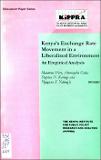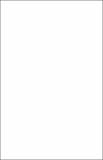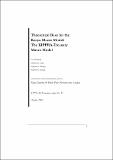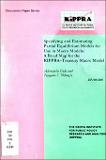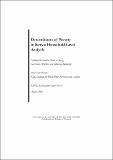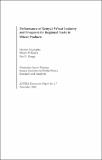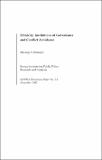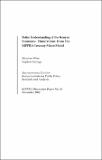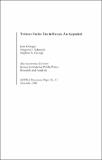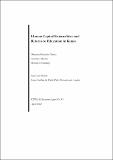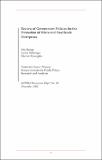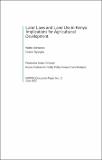Browsing Discussion Papers by Issue Date
Now showing items 1-20 of 348
-
Discussion Paper No. 04 of 2000 on Delivery of Services to Smallholder Coffee Farmers and Impacts on Production Under Liberalization in Kenya
(The Kenya Institute for Public Policy Research and Analysis, 2000)In a liberalized economy, provision of services in the agricultural sector, including financing of inputs, collection of produce, and processing and marketing of farmers' outputs, is a fundamental issue because it affects ... -
Discussion Paper No. 01 of 2000 on the Exchange Rate and the Interest Rate Differential in Kenya: A Monetary and Fiscal Policy Dilemma
(The Kenya Institute for Public Policy Research and Analysis, 2000)The paper analyses the relationship between the real exchange rate and the real interest rate differential on one hand and the implications they have on portfolio capital flows on the other. It shows that the nominal ... -
Discussion Paper No. 07 of 2001 on Vision and Long-term Development Strategy for Kenya's Tourism Industry
(The Kenya Institute for Public Policy Research and Analysis, 2000)This paper reviews tourism performance in Kenya in relation to the policy framework, focusing specifically on the absence of a shared vision and a long-term development strategy. Tourism is Kenya's third largest foreign ... -
Discussion Paper No. 05 of 2000 on Banking Sector Interest Rate Spread in Kenya
(The Kenya Institute for Public Policy Research and Analysis, 2000)A key indicator of financial performance and efficient is the spread between lending and deposit rates. If this spread is large, it works as an impediment to the expansion and development of financial intermediation. This ... -
Discussion Paper No. 10 of 2001 on Kenya's Exchange Rate Movement in a Liberalized Environment: An Empirical Analysis
(The Kenya Institute for Public Policy Research and Analysis, 2000)With globalization has come increased emphasis on an outward- looking and a market-oriented economy. Consequently, the 1990s were associated with a greater degree of liberalization of the financial, foreign exchange ... -
Discussion Paper No. 03 of 2000 on a Review of Kenya's Current Industrialization Policy
(The Kenya Institute for Public Policy Research and Analysis (KIPPRA), 2000)Industrialization has been embraced by many developing countries as a means of achieving structural transformation of their economies. In Kenya, the goal of industrialization has long been held as a strategy for ... -
Discussion Paper No. 02 of 2000 on Macro Models of the Kenya Economy: a Review
(The Kenya Institute for Public Policy Research and Analysis, 2000)This paper critically reviews the existing Kenyan macroeconomic models, identifying their strengths and weaknesses. It argues that there are major weaknesses in the two existing models, MEPM and MELT3, particularly their ... -
Discussion Paper No. 11 of 2001 on Theoretical Base for the Kenya Macro Model: The KIPPRA-Treasury Macro Model
(The Kenya Institute for Public Policy Research and Analysis (KIPPRA), 2001)This paper provides a birds-eye view of the theoretical underpinnings of the KIPPRATreasury macroeconomic model. The model is built mostly along the now fairly standard lines of the aggregate demand–aggregate supply ... -
Discussion Paper No. 06 of 2001 on Beer Taxation in Kenya: an Assessment
(The Kenya Institute for Public Policy Research and Analysis (KIPPRA), 2001)In Kenya, excise taxes on beer contribute a significant share of government revenue. The government is therefore interested in establishing the optimal excise tax rates for the different types of beer-lager and stout. The ... -
Discussion Paper No. 08 of 2001 on Specifying and Estimating Partial Equilibrium Models for Use in Macro Models: a Road Map for the KIPPRA-Treasury Macro Model
(The Kenya Institute for Public Policy Research and Analysis, 2001)Formulating research questions and carrying out empirical analysis is not an easy task. It is particularly difficult for practitioners in government ministries, who are bogged down with the day-to-day running of the ministry ... -
Discussion Paper No. 09 of 2001 on Determinants of Poverty in Kenya: Household-Level Analysis
(The Kenya Institute for Public Policy Research and Analysis (KIPPRA), 2001)Strategies aimed at reducing poverty need to identify factors that are strongly associated with poverty and that are amenable to modification by policy. This paper uses household-level data collected in 1994 to examine ... -
Discussion Paper No. 17 of 2002 on Performance of Kenya's Wheat Industry and Prospects for Regional Trade in Wheat Products
(The Kenya Institute for Public Policy Research and Analysis (KIPPRA), 2002)Wheat is the second most important food crop in Kenya. Wheat production has however declined over the years due to high production costs, high capital costs, lack of credit for production, and the low level of ... -
Discussion Paper No. 23 of 2002 on Ethnicity, Institutions of Governance and Conflict Avoidance
(The Kenya Institute for Public Policy Research and Analysis (KIPPRA), 2002)Post-independence Africa has been marked by numerous ethnic conflicts. These conflicts have adversely impacted on the quality of life and have greatly undermined the continent's prospects for development. In addition to ... -
Discussion Paper No. 16 of 2002 on Better Understanding of the Kenyan Economy: Simulation from the KIPPRA-Treasury Macro Model
(The Kenya Institute for Public Policy Research and Analysis (KIPPRA), 2002)Since the pioneering work of Tinbergen in the late 1930s, the use of macroeconomic models as vital instruments for policy analysis has gained considerable interest. Based on historical behaviour of an economy, an ... -
Discussion Paper No. 21 of 2002 on Tobacco Excise Tax in Kenya: an Appraisal
(The Kenya Institute for Public Policy Research and Analysis (KIPPRA), 2002)Excise taxes form a substantial proportion of revenue for governments all over the world, and especially in low-income developing countries. Excise taxes are levied on a few goods characterised by low price elasticity ... -
Discussion Paper No. 13 of 2002 on Human Capital Externalities and Returns to Education in Kenya
(The Kenya Institute for Public Policy Research and Analysis (KIPPRA), 2002)This study has used micro data to analyse the effect of human capital externality on earnings and returns to education. The parameters of the earnings function are estimated using the ordinary least squares method. The ... -
Discussion Paper No. 20 of 2002 on Review of Government Policies for the Promotion of Micro and Smallscale Enterprises
(The Kenya Institute for Public Policy Research and Analysis (KIPPRA), 2002)The Micro and Smallscale Enterprises' (MSEs) sector in Kenya has grown tremendously over the last two decades despite poor policy conceptualization and implementation in the sector. However, this growth is characterized ... -
Discussion Paper No. 15 of 2002 on Land Laws and Land Use in Kenya: Implications for Agricultural Development
(The Kenya Institute for Public Policy Research and Analysis (KIPPRA), 2002)Land is both a ‘social’ and economic asset. As an economic asset, land works either as a financial tool or production tool. Land as a production tool is essential in production of agricultural goods. At the same time, land ... -
Discussion Paper No. 22 of 2002 on Analysis of Kenya's Export Performance: An Empirical Evaluation
(The Kenya Institute for Public Policy Research and Analysis (KIPPRA), 2002)With globalisation, export-led growth strategy has become a major focus for many countries including Kenya. Although there have been efforts towards diversification of the export sector, Kenya’s exports are still dominated ... -
Discussion Paper No. 12 of 2002 on Predicting Household Poverty: A Methodological Note with a Kenyan Example
(The Kenya Institute for Public Policy Research and Analysis (KIPPRA), 2002)Identifying and measuring poverty require data on economic conditions of households and individuals. Such data are typically gathered through household surveys. Household surveys collect data on demographics, incomes, ...





